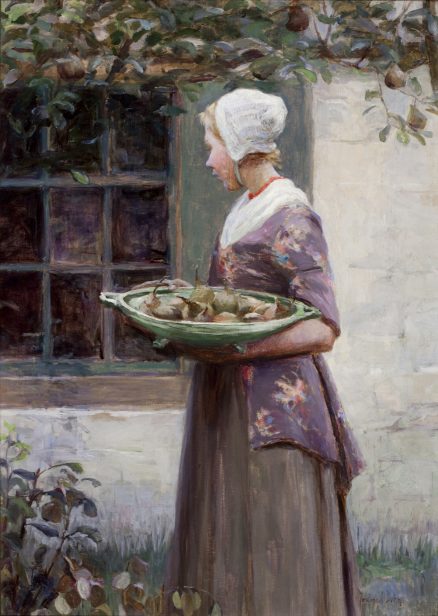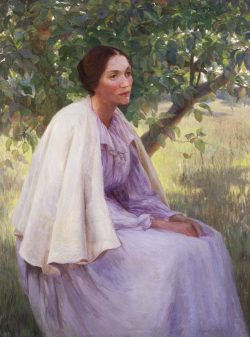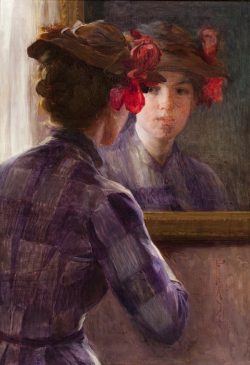- Categories
- Figural works
- Women
- Women artists
- Zoom in on Artwork
- Print Page
- Email Page to Friend
The subject of Pauline Dohn’s Pear Time is apparently simple. A young woman, dressed in peasant garb, stands against the white stucco exterior of a rural building. She holds a large platter of pears, and more fruit hangs from a bough extending across the composition just above her head. The only other details of the setting are the leafy plants filling the lower-left corner of the image and the rough grass fringing the wall where it meets the ground. Dohn’s picture hints at a narrative, a purpose to the young woman’s pose and the objects she bears, but it leaves much to the viewer’s imagination: her destination, the intended recipient of the platter, and the object of her immediate interest as she turns her head away from the viewer. Setting the subject’s white cap against the darker vertical band of the deep window recess, Dohn orchestrated a subtle range of values and harmonious cool colors for decorative effect. The naturalistic lighting and detail of Pear Time reflect the artist’s careful study of her model and her sensitivity to the singular qualities of diffused natural light for which northern France and Holland were renowned among late-nineteenth-century American expatriate painters.
Dohn painted Pear Time during the summer she spent in rural Holland in 1895. There she worked with American expatriate artists Gari Melchers and George Hitchcock, who had settled in the village of Egmond aan Zee to paint local peasant life. Dohn and Melchers reportedly worked from the same model, and in both Pear Time and her painting The Seeker, Dohn followed both her mentors’ example by focusing on a single female figure posed outdoors in subtle light conditions. Influenced like her associates by the works of French painter Jules Bastien-Lepage, Dohn favored cool, silvery hues and combined fidelity to local detail with symbolic or religious overtones. In this work, the model presents the pears as if an offering, evoking the fruit’s ancient associations with gardens, fertility, and affection and suggesting a metaphor for her burgeoning sexuality. Included in the Art Institute of Chicago’s annual exhibition of American art in late 1895 and in the 1898–1899 annual show of the Society of Western Artists, Pear Time was praised by venerated Art Institute drawing teacher John Vanderpoel as “a charming out-of-door arrangement, skillfully painted.”i The Chicago Tribune’s reviewer ranked the painting “among the most satisfactory things the exhibition contains” when Pear Time was featured in the 1895 show of the Palette Club, a Chicago women artists’ organization.ii
Wendy Greenhouse, PhD
i John H. Vanderpoel, “The Society of Western Artists,” Brush and Pencil 3 (Dec. 1898): 161.
ii “In the Art Studios,” Chicago Tribune, Dec. 15, 1895.


